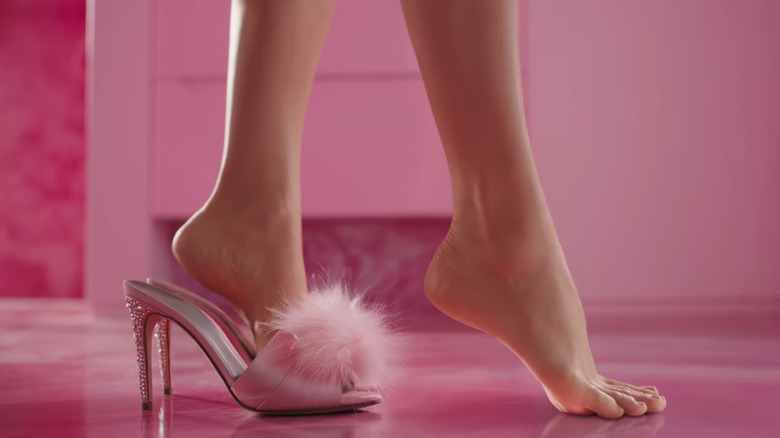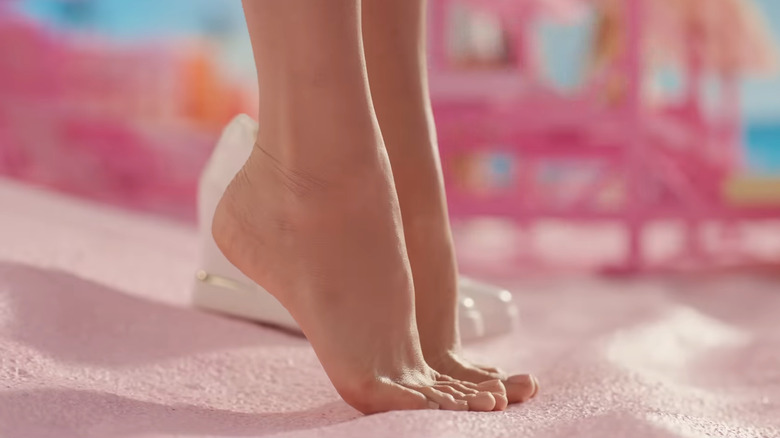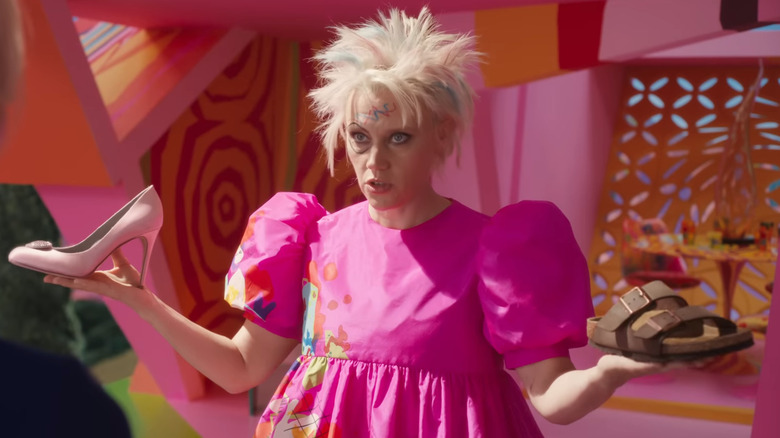Here's Why You Don't Want Barbie Feet In Real Life
Whether you like it or not, Barbie is an icon, and she'll probably remain one for decades to come. While Barbie has been criticized for promoting unrealistic body expectations in the past, we (and Barbie) have come a long way since then. Some might even have forgiven the popular doll for the mishaps of the past, but now Greta Gerwig's "Barbie" film has unintentionally started a new social media trend where people try to mimic the look of Barbie's feet — we simply can't seem to resist Barbie's temptations.
The movie trailer had barely dropped when one TikTok user, Shanna Scribner, posted a video of themselves mimicking the scene where Barbie, played by Margot Robbie, effortlessly steps out of high heel shoes, her feet remaining perfectly arched, even without the support of the heels. Does it look pretty graceful? Yes. Would it make you look taller? Yes. Will your legs and feet be fine after doing this for an extended period of time? Hell no. While it would be interesting if everyone suddenly started walking on their toes, the human body was not designed to move this way, and you wouldn't actually be able to achieve arched feet even if you did.
What's more, you really don't want Barbie feet — just ask 20% of the population who actually do have high arch feet that mirror Barbie's. This condition is known as cavus foot, and it can be incredibly painful to live with when you're not made of plastic.
The Barbie feet challenge is riskier than you think
Aside from the obvious risk of falling flat on your face, the Barbie feet challenge taking over TikTok can bruise more than just your ego. While this challenge can definitely be good fun and probably won't cause painful feet (unless you practice getting a perfect take for hours on end), trying to achieve Barbie's high arch (especially by wearing high heels all the time) can lead to plenty of issues you really don't want to deal with.
The Barbie feet challenge on TikTok has almost 60 million views and growing, with TikTok user lifeof.lori even attempting the challenge en pointe while stepping out of their ballet pointe shoes. Yeah, we can't stop watching either. Clearly, this trend isn't slowing down anytime soon, but experts warn that as fun as it may look, this challenge might do more harm than good.
Speaking to PopSugar, celebrity podiatrist, Marion Yau explained that even putting your foot in that unsupported arched position for a short amount of time isn't exactly safe, especially if you do multiple takes. "Putting your foot in an unnatural position for an extended period of time increases your risk of muscle imbalance, ankle sprains, tipping, foot pain, calf pain, and corn buildup," Yau warns. Double-board-certified podiatrist Chanel Perkins, DPM, agrees. "Pain in the toes and the ball of the feet are likely to occur simply from the forward shift of gravity needed to attempt the Barbie challenge," Perkins cautions.
Barbie feet is a real, painful condition known as cavus foot
Margot Robbie's elegantly arched feet in "Barbie" might look good, but those who live with high arch feet will tell you that life's way better when your feet don't look like Barbie's.
Those of us who have a typical arch take for granted the fact that our feet can carry and distribute our body weight evenly. Those with high arches generally deal with muscle weaknesses and imbalances because of uneven weight distribution in their feet. This condition is known as cavus foot.
Because a high arch drastically changes the structure of the foot, it's also way less adept at absorbing shock. Throw it all together, and you find yourself prone to injuries like bone fractures and ankle sprains. This awkward weight distribution affects the ankles and toes and can cause pain. People with high arches typically deal with extensive pressure on the ball and heel of their foot, which can impact the structure of the foot permanently. Once this happens, you'll need treatment to manage the discomfort, Cleveland Clinic warns.
This just goes to prove that life in plastic might be fantastic if you have cavus foot, but like most things relating to Barbie, high arch feet simply aren't all it's cracked up to be in real life.
If you have Barbie feet, you probably already know it
If you have high arches aka Barbie feet, it's very likely you already know. A simple look in the mirror can already tell you plenty — if you have a high arch, you'll notice the center of your foot only touches the ground slightly or not at all. Still in doubt? WebMD suggests grabbing a piece of cardboard, wetting your foot in some water, then stepping onto the cardboard and checking your footprint. People with average arches will usually be able to spot the imprint the arch of their foot made. If you have a high arch, however, you might only spot the imprint of your toes and heel. Sometimes, a very small part of the arch might be visible. Either way, this is an indication that you might have cavus foot.
Other signs that indicate a high arch include calluses, claw toes, and hammer toes, according to Healthline. Moreover, Intermountain Health explains that people with high arches usually notice the most pain when they're on their feet for any period of time. The pain might be limited to the foot but tends to spread upward as you continue throughout your day. You might notice discomfort in your legs, thighs, and hips. High arches can also make it hard to find comfortable shoes — if your foot's curve always seems to be the reason you can't fit into some footwear, it's likely a high arch is to blame.
Cavus foot needs to be officially diagnosed by a doctor
While Barbie feet can be easy to spot on your own, it's best to go see your doctor for an official diagnosis, especially if you're experiencing pain in your feet and legs on a daily basis.
In an article for Top Doctors, foot and ankle specialist Tarek El Gamal wrote that the process of diagnosing cavus foot is pretty straightforward. Your doctor will do a physical examination, studying the way you walk and stand on your feet. They'll also ask you where you experience pain. WebMD notes that doctors will sometimes test the flexibility of your arches as well. El Gamal mentions that he'll usually run tests to rule out any serious causes of cavus foot. You may be booked for spine scans and neurological tests to eliminate potential causes like cancer. Other tests include electromyography, a nerve conduction study, X-rays, and magnetic resonance imaging (MRI).
Cavus foot can be hereditary, so doctors will typically ask you if you have any family members with the condition. They might also suggest you undergo genetic testing to determine whether you can pass on the condition.
Barbie feet can actually cause plenty of painful conditions
It might look pretty, but real-life Barbie feet can lead to plenty of painful conditions. Considering we rely on our feet to carry us wherever we go, dealing with pain in this area can be nothing short of a nightmare. In fact, many people with cavus foot probably gritted their teeth in anticipated pain when they saw that famous shot of Margot Robbie stepping out of her high heels. The truth is that it took Robbie eight takes to get it just right, and she had tons of help. She told Fandango during an interview that she held onto a bar and had the help of double-sided tape on the floor to keep her shoes in place as she stepped out of them.
Those with cavus foot, however, are stuck with their high arches and often deal with painful conditions like metatarsal fractures. According to Cleveland Clinic, this condition refers to tiny fractures that occur in the foot's bones over time due to the continued stress the high arch places on them. Ouch! Inflammation in the ball of the foot is also very common. The medical term for this condition is metatarsalgia, and it usually flares up when you spend a lot of time on your feet. Then there's plantar fasciitis, which is inflammation of a ligament called the plantar fascia. It's as painful as it sounds — when this ligament becomes inflamed, it can cause intense pain in the heel.
Barbie feet can sometimes be caused by underlying health issues
The scariest part about real-life Barbie feet is it can sometimes be a symptom of another serious underlying health condition. In some cases, certain neurological diseases are the culprit, the most common of which is Charcot-Marie-Tooth disease (CMT). This disease causes neuromuscular contractions, which can affect the arch, causing it to lift as the contractions shorten the muscles in this area, Verywell Health explains. Spina bifida, a deformity of the spine and spinal cord, can also lead to cavus foot.
Cerebral palsy is another culprit — this neurological condition affects the muscles, causing weakness. Another very serious underlying cause of cavus foot is post-stroke paralysis. This condition can affect various parts of the body, depending on the area of the brain that was damaged during the stroke. While it can lead to weakness or paralysis on one side of the body, it can also affect your feet, leading to cavus foot. Cavus foot can also be caused by poliomyelitis (often just referred to as polio). This viral disease attacks the nervous system, which can lead to paralysis if not treated successfully.
Another cause of cavus foot is clubfoot. This is a foot deformity people are born with, but it can be corrected before it starts to cause problems. Muscular dystrophy is another possible cause of cavus foot, caused by diseases that break down muscle mass. Oftentimes, though, cavus foot simply develops without any underlying conditions because it runs in someone's family.
You need surgery to correct Barbie feet permanently
In the film, we see Barbie fall face-first into the sand when her feet magically flatten. The freakout that follows when she shows her friends is hilarious, but people with cavus foot will tell you that they wished movie magic extended to the real world because if you want to fix a high arch permanently, surgery is really your only option.
Verywell Health notes that there are three types of surgery that are often used to correct a high arch (we're sure Barbie and her friends would shudder at the thought of having their feet flattened), but you need to keep in mind that all these procedures come with some risks. One of the more extreme procedures is arthrodesis. This surgery is only performed if your foot's arch is severely compromised and consists of moving bones and fusing them together.
Then there's tendon transfer surgery, which can restore the foot's mobility and alleviate built-up tension. The surgeon moves a tendon (they don't actually transplant it) to achieve this. The downside is that you'll need intense physical therapy to learn how to use your foot properly again after the procedure. Plantar fascia release is another option, which consists of making a small partial cut in the tendon that connects the ball of the foot to the heel. Osteotomy is another drastic surgery consisting of cutting the actual bone in your foot to change its original structure to a more comfortable version.
High arch surgery comes with various risks
While life in plastic means you don't have to deal with any bleeding or nasty infections, real life comes with real complications (as Barbie learns all too soon when she enters the Real World). Any surgery comes with risks, and when you opt to have your high arch surgically corrected, it's good to know what to expect. As always, there's a risk of infection and the possibility that you might be allergic to the anesthesia administered during the procedure. Cleveland Clinic notes that more serious complications like blood vessel damage, blood clots, nerve damage, excessive bleeding, and chronic pain after surgery are possible.
Verywell Health adds that other complications like deep vein thrombosis, blood clots, and inefficient bone and wound healing are also possible. With that said, you shouldn't let the potential risks scare you off, especially if you're always in pain because of your high arches. It's important to note, however, that if your cavus foot is caused by a neurological disease, it's possible that you'll need to undergo repeat surgery to maintain the results. The best thing to do before you make a final decision about the surgery is to speak with your doctor about the various surgical options and ask them any questions you might have.
Non-surgical treatments exist but aren't always successful
If the idea of surgery freaks you out more than Barbie's flat feet freaks out her friends, there are some non-surgical treatments you can consider. In fact, you'd be better off trying these treatments first before diving head-first into a surgical procedure, because you might end up not needing surgery if these treatments work.
Intermountain Health explains that oftentimes, those who have flexible arches, even if they are unnaturally high, can live a perfectly pain-free life (those are the lucky real-life Barbies). If you do experience pain, doing some foot stretches can go a long way. In fact, your doctor might recommend you start off with these when you are first diagnosed with cavus foot. They can give you specialized exercises that can stretch and strengthen the necessary muscles to prevent and treat pain. Buying the right shoes can also go a long way. Orthotic shoe inserts can make a world of a difference, as can wearing corrective shoes.
In some cases, losing weight can also make a difference, especially if someone is overweight. Losing a few pounds can take some pressure off the feet and relieve pain. You can also consider seeing a pain management specialist who specializes in helping patients manage chronic pain and could help you treat the discomfort of cavus foot without the need for surgery.
The Barbie feet challenge can be safe and even beneficial if you do it right
While you definitely shouldn't be walking around Barbie-style unassisted, experts say that coming up onto your toes every now and then can actually be good for you — if you do it right. There's a reason ballerinas have strong calf muscles — they do a lot of work on their toes! Speaking to PopSugar, double-board-certified podiatrist Chanel Perkins, DPM, recommended you do some heel raises while holding onto something for support to work those calf muscles. Doing this exercise can also bring relief to those who have plantar fasciitis. "That motion stretches out the plantar fascia ligament, eradicating tightness and easing soreness," Perkins explains.
So, if you're scared to try the Barbie feet challenge now that you know all about what could go wrong, you don't have to be. It can still be fun as long as you do it with proper support, Perkins says. Celebrity podiatrist Marion Yau adds that "there is not much danger when doing it for a few seconds."
Perkins has a few tips for keeping it safe and fun, which include opting for lower heels and avoiding hard and slippery surfaces — a carpet is your friend. "Aim for no more than three 10- to 15-second attempts," Perkins advises. Yup, getting it right in three attempts is a challenge in itself, but then again, even Margot Robbie couldn't manage that, so we shouldn't be too hard on ourselves.










